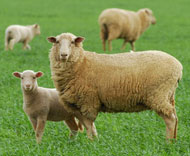
New national OJD management plan commencing 31 March 2008

A new national OJD management plan (OJDMP) commenced on Monday 31 March 2008 following the end of the 2004-2007 plan.
The new national plan has four main objectives:
- To minimise the risk to properties and geographic regions which currently appear disease free, and actively manage incursions when they occur;
- Reduce the area prevalence in regions where the disease is endemic through the use of vaccine and the implementation of grazing management practices to minimise the exposure of stock to Mycobacterium paratuberculosis subsp. avium (Mptb);
- Promote the benefits of active biosecurity planning to manage disease risk at the individual property and regional level;
- Provide improved trading opportunities for producers who actively manage the disease through the use of the Assurance Based Credit (ABC) Scheme.
The OJDMP is the culmination of extended consultations between WoolProducers Australia, Sheepmeat Council of Australia and peak state organisations which seek to continue to encourage producers to undertake risk assessments prior to the purchase of stock, in addition to controlling OJD through vaccination and on-farm management practices.
Responsibility for the ongoing operational management of the OJDMP rests with state governments and the National Sheep Industry.
The OJDMP is coordinated by Animal Health Australia on behalf of stakeholders.
Nationally accepted standards and practices for the OJDMP are documented on the Animal Health Australia website.
Management Areas and Exclusion Areas
NSW includes three different prevalence areas, reflecting a gradient of estimated infection levels, but the state continues to be essentially managed in two parts.
The Management Areas, mainly comprising the higher prevalence areas, continue to encourage producers to manage their own risk by developing property biosecurity plans that include strategies such as vaccination, on-farm management, and informed purchase of sheep.
The Exclusion Areas, comprising most of the low prevalence regions, are self-funded and self-managed district biosecurity risk management programs designed to slow the potential spread of OJD into and within the area.

